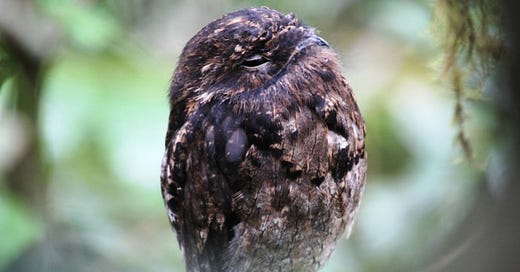OK wow this Bird of the Week, the common potoo, wowie wow wow. Let's get right to it. Look at the bird.
I mean!!!!!!! The common potoo (also known as a grey potoo, a lesser potoo, which is kind of rude, and a "poor-me-one" which is awesome and comes from the sound of their calls, which we'll get to) is one of seven species of potoo, a nocturnal bird found in Central and South America. Go to, say, Panama, or pretty much any part of South America north of about Argentina, and there the common potoo will be, hanging out on a stump. The potoo loves a stump, or tree branch, day and night. It just sits there, waiting to eat insects and blending in perfectly with its surroundings. Like, really perfectly! Common potoos don't even build nests. They just park on a stump and know their natural disguises will see them through.
That is a common potoo and a potoo chick, showing how it's done.
I actually kind of buried the lede here because I showed you a picture of a common potoo with its eyes closed. This is not important to the potoo, because it has little notches in its eyelids that make it possible to see even when its eyes are closed. But it is very important for us, because, well, look.
I know right?????? Just, yeah. You can tell the bird is nocturnal because, well, of course you can. The eyes the eyes! I'm going to share some hilarious "amaze-wing facts" about the common potoo from a website for children, and then I am going to show you a lot of videos because that is the best thing to do. First, the "amaze-wing facts," as collected by a website called kidadl.com (no, this is not the children's version of the Anti-Defamation League, I checked, though it is definitely kind of weird):
What do they prey on? Flies, moths, cicadas, beetles, grasshoppers, ants, flying mantises, and small vertebrates.
Where does a common potoo live? The potoo bird's habitat includes open woodlands with trees and savannahs. According to the IUCN, it is found in the terrestrial biome ecosystem and the realm is neotropical. It is found sitting in branches of trees and camouflages itself against the branches. This kind of mimicry helps it to hide in plain sight.
How cute are they? Common potoos are often called comical for their appearance and may not be termed as cute. [Ed. note: speak for yourself, kidadl.com!]
Would they make a good pet? The potoo bird is essentially a wild bird and is reclusive by nature. They do not even stay close to other potoos, and so they can't be considered as pets.
I love learning! Let's do videos now, because you MUST see the common potoo in action to experience it. A lot of these videos have cheesy music or narration, but I will take what I can get. Here is just an overwhelmingly cute video of a potoo and a potoo chick, AHHHHHHH! (And yes, the cover image on this video is a little jarring, but trust me the video itself is cute.)
That was also the first chance you got to hear the immortal call of the potoo. People go nuts over the call. Here's Lucas DeGroote of the Powdermill Avian Research Center:
The mournful descending cry of the Common Potoo, Nyctibius griseus, is the subject of poetry and lore. Alexander Skutch (1970) described the Common Potoo’s voice as “the most melancholy utterance I had ever heard from bird or beast. Although plaintive, the Potoo’s soft, soprano notes were so beautifully modulated that they brought to mind a phrase from Shelley’s Adonais, ‘most musical of mourners’”. In folklore Potoos are similarly anthropomorphized as mourning the loss of a loved one. A child crying for their mother who abandoned them, a chieftain’s daughter mourning her suitor murdered by her father, or a wife crying for her husband who left and became the moon because she didn’t prepare enough pumpkin for dinner (Hernandez 2016, WikiAves 2020). These legends and others form the root of their name in Brazil where they are called Mãe-da-lua “Mother of the Moon” or by the Tupi of the Amazon as Urutau “ghost bird”. For all these reasons, Common Potoos are highly sought after by birders and photographers.
Yeah, what they all said! More videos now. This one has EVERYTHING: the potoo at night, the potoo calling, the potoo being disguise-y....
And here is one of the potoo catching a fly with its eyes closed.
In conclusion, YES.
A reminder: you can check out our complete Bird of the Week list here, and get in touch with your bird suggestions at hello@discourseblog.com.








